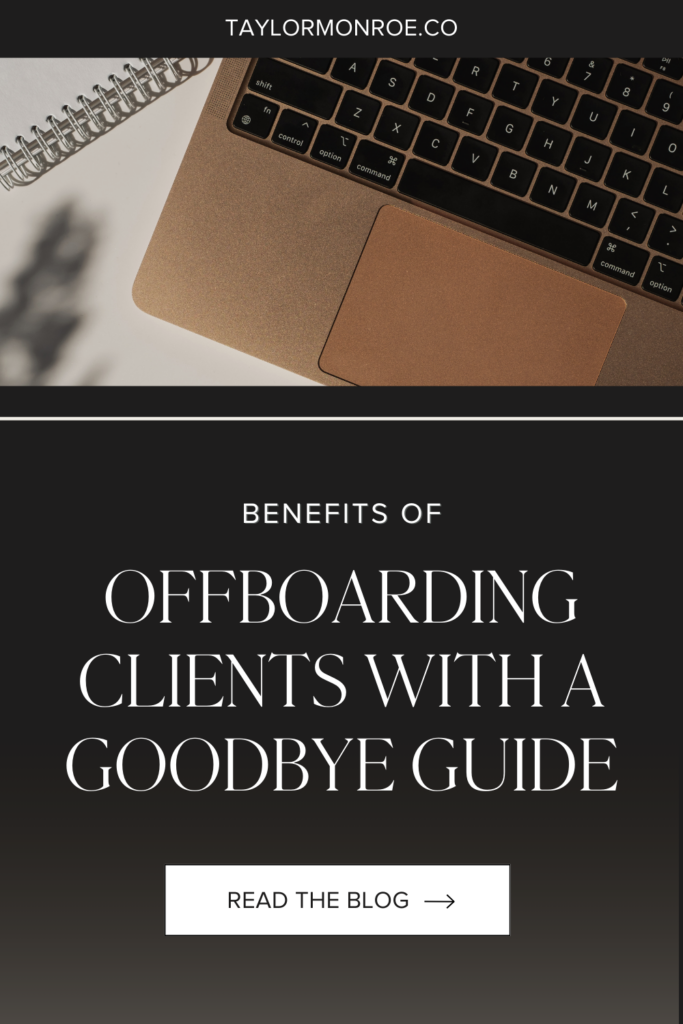go back
A Goodbye Guide is essential for any project! Especially if you’re intending on ending a client relationship on a great note (and I have a feeling you are!). But, with the excitement of a finished project on the horizon, you might be caught up in what exactly your client needs to head out on their own.
Have no fear, the uncertainty ends today! If you’re ready to create a stellar offboarding process and wow your client with your organization, continue reading to learn all the benefits of offboarding clients with a goodbye guide (plus, how to create one for your business).
Pin this blog for later! ↓

Please note that some links in this blog post are affiliate links, which means we may receive a commission if you purchase using our link. Honestly, we just love sharing what we’ve been loving lately, and if that means you can get in on the sweet deals as well, then great!
What is a Goodbye Guide?
If you’ve never sent a Goodbye Guide before, we need to start by clarifying some things (don’t sweat, I promise this will all make sense). Essentially, your Goodbye Guide is the final farewell to your clients. No matter the industry you’re in, your Goodbye Guide will include every single piece of information your clients could ever need from you. Think about it like an overprotective mom sending their kid off to camp: Will they need all the band-aids, bug spray, and changes of clothes she’s packed? Probably not! But will it prepare her kid for anything that pops up? Oh, absolutely!
Seriously. From the minute details to the most expansive elements of your project, your Goodbye Guide needs to include it all. While it can be hard to let go of clients (maybe you want to hang onto that excitement for just a little while longer), I promise you, your guide is important in making a clean break. So, ensure your client (and you!) have an indication that signifies the end of your project.
You know we’re all about streamlining processes around here and the offboarding process is just as important. Let me show you why.
Why Use a Goodbye Guide?
So, now that you know what a Goodbye Guide is, it’s time to explore why you should be using one! Every amazing entrepreneur (and I know that’s you) should be using a Goodbye Guide if they want to make a great impression on their clients. Yes, even when you’re saying goodbye!
Don’t believe me?
Well, the way you end one project sets the tone for future collaborations between you and your client. Who do you think they’re going to pick for their next project if you completely botch your end-of-work duties? Because, in the world of business, nobody makes choices out of loyalty alone. That’s why I always emphasize the importance of your client-facing processes.
Not to mention, referrals are a business owner’s best friend. Referrals highly cut down on your marketing efforts and (bonus!) there’ll already be a level of trust built between you and this new client (as I’m sure you come highly recommended!).
Even more, as mentioned above, your Goodbye Guide acts as the signal that your project is finished. So, this means that you won’t be bombarded with an endless array of questions or experience the post-breakup awkward stage (who said business wasn’t like dating?). Not to mention, your guide will give your clients access to a cheat sheet of the work you’ve done. So, whether you’re a photographer, designer, or other service-based business, you’ll know that your clients are well taken care of.
Want to see this in action? Here are all the fun things that should be included in your Goodbye Guide.

What’s Included in a Goodbye Guide?
Assets
Your assets are any deliverables that you give to your client when finished with their project. You should highlight where your clients can find these assets (remember to make it as simple as possible), how long your client will have access to these important assets, and whether your client should be sharing or copying important documents, files, etc.
A rule of thumb to follow: Give your clients more information than they’ll ever need. They can always refer back to the guide!
Here are a few examples of important assets:
- Design assets – Hex Codes, Brand Fonts, Brand Guidelines.
- Copy Documents – Where all final copy is neatly presented.
- Photo Galleries – Your gorgeous, gorgeous pictures.
- Login information for programs – Website designers, make sure your clients actually have access to their own website and any hosting logins!
- Details on programs that you’ll no longer manage – In case of emergency, who can they contact for help?
- Brief instructions on their assets – How to best use what’s included in their final deliverables, such as copy, design, or photos.
FAQs
To lower the amount of post-project emails you receive, be sure to address any common questions you typically receive. You’re their rockstar (and maybe even a little psychic.) So, answer your client’s questions before they even have a chance to ask!
Not sure where to start with your FAQ? Here’s an idea of what to include:
- Think of previous things clients have asked you after finalizing their projects. Was anything not clear?
- Are they looking for a certain type of vendor?
- Photography clients are always asking for photo books. Is this a service that you offer? If yes, be sure to include pricing information and design examples. If not, who do you recommend? The same goes for printing photos. Whether it’s prints, canvases, or products, give your clients the opportunity to actually showcase your work.
- Copywriters: Do your clients normally ask for design recommendations to build from the work you created? Refer away!
Extra Services
No one said that you can only offer one service to a client! Let your expertise shine!!
This is the time to list the services you offer beyond what your client hired you for. Listing your other offers is especially key to continuing a great client relationship and making some serious cash for your business. We know that it’s more expensive to onboard a new client, so this is why retaining old clients with newer services is so important! Your business exists to solve problems and the way you create your packages should meet clients at their different levels of need.
Referral Bonuses
Referrals should be a key pillar of your business! Not only do they mean that you’re doing something incredibly right with your current clients, but it cuts down on your marketing efforts.
And it’s usually a win-win for you AND your client. If you don’t have a referral program in place, it’s time to get you squared away. Ask yourself how much your client would receive for sending a client your way. Then, figure out whether you’ll be compensating them through direct payment or whether it’ll be a percentage off their next service booked.
Important Details About Their Deliverables
It’s time to get technical with it. While we’ve already compiled a list of your assets, be sure that your clients actually understand how to use these assets. It’s one thing to dump a bunch of information on your client’s lap, but it’s another thing completely to explain the important details of how each asset works and when the appropriate time to use them is.
How to Format Your Goodbye Guide
Now that you’ve learned all there is to know about creating a show-stopping Goodbye Guide (YAY!), it’s time to format this baby and make it as beautiful as possible. Your business is known for producing high-quality results (go you!), so your Goodbye Guide should be finessed with that same passion and attention to detail.
First, your Goodbye Guide should always be branded to your company (duh!). From there, your guide should flow from beginning to end – an introduction and conclusion page never hurts.
Before finishing off your guide, be sure that you ask for a review or feedback. This is the opportunity to learn more about what your clients enjoyed and what can be improved upon for future clients. So, send it on over along with your testimonial form.
Here’s a great suggestion for you: Have different versions of your guide for each client project type. Each guide should include separate directions for how to use and find assets while promoting different services that you offer! This is the type of detail that goes above and beyond and makes your guide feel that much more personalized.
Finally, above all else, don’t forget to streamline the process! Your guide can easily be added into your offboarding workflow (we like to use a Canva link so that any updates you make are automatically reflected in your workflows and past clients!).
A Goodbye Guide is like the cherry on top of the cake. At first, it might seem useless or a waste of time to include. But, in reality, it ties everything together. Your Goodbye Guide is the final stamp you make on a client project, and it sets the tone for everything that comes down the line.
So, you’ve already got your Goodbye Guide ready (and used our helpful tips to finish it off), but you don’t have a systemized workflow to plug it into? Maybe you’re sending it manually at the end of each project. I’d highly recommend setting up your process in an automated way to cut down on your administrative work! With our aesthetics-driven approach and client experience knowledge, we can help you create an offboarding workflow that will have your clients eager to refer you to their network. You can learn more about our client experience setups here!
up next
